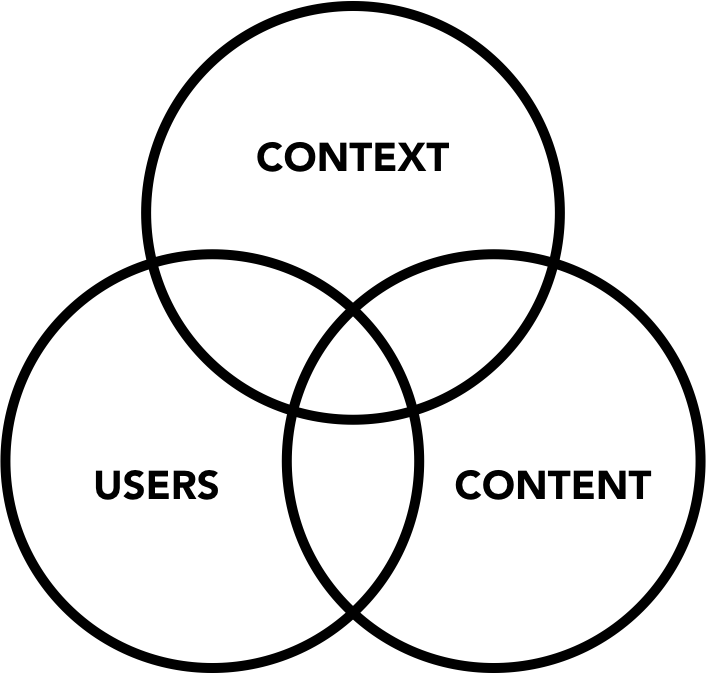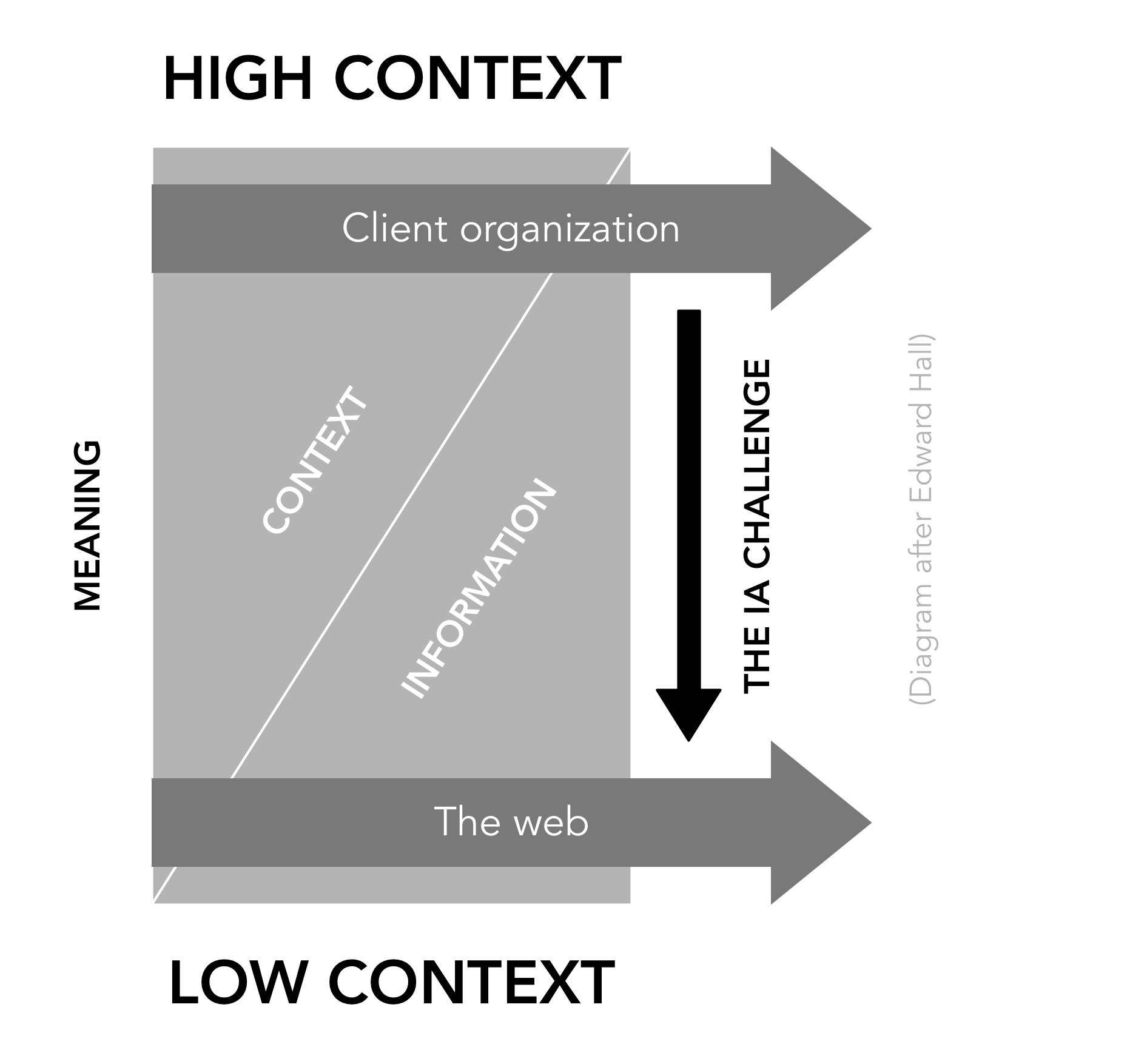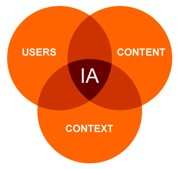This post was originally published in Boxes and Arrows.
Let me share a silly joke with you:
Q: Why did Lieutenant Worf change his hair color?
A: Because it was a good day to dye.1
Do you get it? If so, you understand who Worf is and what his character is like. For this joke to make any sense, you need to be part of a clique—Star Trek fans, in this case—with a shared base of understanding. In other words, the joke relies on context for its effectiveness.

Context is the frame of reference that gives meaning and proper perspective to a communication. Pervasive and inescapable, its importance to information architecture is evident in it being one of the three circles in the oft-referenced “Scope of IA” Venn diagram from the Polar Bear Book. While users and content (the other two circles in the diagram) are intensely scrutinized by information architects (most tools and methodologies we employ seem to reside in these two fields), the profession has developed few techniques to deal methodically with the “soft” issues addressed by context (business models, politics, culture, social dynamics, etc.). Context is deeply ingrained in us, so we tend to relegate the issues it raises to a set of background assumptions that we believe to be shared by all parties involved in a project or organization.
This belief may not always be accurate; people have differing assumptions and expectations that affect how they relate to the people and the world around them. While ignoring these differences can obviously cause problems when we’re designing sites targeted at people from other cultures, it may also lead to miscommunication with folks in our own culture or organization. On the other hand, information architectures that take these differences into consideration can help express these unspoken assumptions in meaningful ways, allowing the sites we produce to communicate more effectively.
The role of context in communications: Hall’s model
Effective communication, in any medium, depends on both parties sharing a frame of reference. In his book Beyond Culture, American anthropologist Edward Hall argues that the effectiveness of a communication between two people depends on the amount of context they expect to be present in the communication.
In Hall’s model, High context (HC) communications convey much of the meaning of a message in information that is pre-programmed beforehand in the speakers and the setting of the communication. In other words, much of the message implied by who the speakers are, their relationship to one another, where they are communicating, etc. A typical HC situation would be your family’s holiday dinner party: the way you communicate with the other people there, the manner in which jokes are told and interpreted, and the special places reserved at the table for certain members of the family are all “rules” that are agreed to by all, yet not written down in any formal manner beforehand. The bounds of these relationships have emerged naturally through the interactions of these people—and you—over the years.
Low context (LC) communications, on the other hand, are the opposite: the bulk of the meaning is carried in the message itself, with little left open to interpretation. LC environments and situations rely on formal rule systems to define interactions between different parties. For example, a supermarket supply chain is the process by which a bunch of grapes in a field in Spain can end up being poured from a bottle of wine into a glass in your kitchen table. This exacting system requires all parties involved to interact as efficiently as possible; even minor mistakes can result in millions of dollars lost. In order to minimize failures, formal rules clearly define the relationships and interactions between the parties that make up the supply chain, and these rules are communicated in ways that leave very little open to interpretation.
In studying different cultures around the world, Hall discovered that some tend to be more context-dependent than others. For example, French institutions tend to be more HC than their American counterparts. The French legal system, for one, accepts contextual information about a case (e.g. hearsay, details about the accused person’s character) that would probably bewilder an American attorney.
Of course, it is impossible to generalize: nations are not completely homogeneous, and the institutions that comprise them vary in their degree of context. Besides, organizations and institutions can also have “cultures,” and these can also be subject to differences in contextual dependency.
Deep structural differences between the two communications systems have important effects on how societies and groups develop over time. For example, HC environments and systems tend to be relatively stable—they are long-lived and slow-changing. LC environments, on the other hand, adapt more quickly to changing situations, because they more easily redefine relationships that are established by explicit, mutually agreed-upon rules systems. (Think of the relative stasis of imperial dynasties versus the dynamic “messiness” of democracies.) As a result, members of HC and LC societies show marked differences in their communication styles and social dynamics.
Culture and the Internet medium
Hall defines culture as:
… what gives man his identity no matter where he is born—the total communication framework: words, actions, postures, gestures, tones of voice, facial expressions, the way he handles time, space, and materials, the way he works, plays, makes love, and defends himself.
As a part of this communication framework and a medium for the transmission of cultural information, the Internet is a particularly LC environment. For example, given a single item of content on the web, it is often difficult to ascertain its authorship and the contextual information that usually accompanies the author. These are key details that profoundly influence the way the reader interprets the information; if they are not present (or not clearly presented), the meaning of the message can be radically misunderstood. (Thus the punch line of the classic New Yorker cartoon—“On the Internet nobody knows you’re a dog.”)
Because of the decentralized nature of the Internet, it is also very difficult to establish contextual relationships between sites. By its very design, the web flattens the relationships between morsels of information, and, by extension, the organizations that publish them. For example, a search in Google for “US Immigration” reveals a mix of official government sites that provide information for prospective immigrants, and official-looking commercial sites with other (perhaps less noble) objectives in mind. A user lacking the contextual information provided by an understanding of the American immigration system (or Internet domain naming schemes) may well choose the wrong site, with potentially disastrous results.
On the other hand, many of our clients’ company cultures tend to be HC environments: they have a particular value system, a history, and a “special” way of going about their business. This “company culture” is often transmitted informally by peers in the organization, or by management in corporate pep talks, but is rarely stated formally in a rulebook. In some organizations, this zeitgeist is explicitly stated as a differentiator that sets the organization apart from its peers (e.g. “The HP Way”).
The role that the organization plays within its larger social group also changes the meaning of the message it intends to communicate. Simply stated, who they are makes a difference in how people understand what they say. In a recent post in his blog, Diego Rodríguez called out a strange recurring typo in the US Federal Aviation Administration website:
I actually like the word “frequestly”, and would find it to be brand enhancing if I heard it from Cranium or Virgin or Mini, but when the FAA speaks, we need it to sound like James Earl Jones. We want the FAA to show us at every opportunity that they have their act together.
In other words, this contextual information (the role of the FAA in American society) changes the user’s interpretation of the content. When context and content are in discord, the user perceives that the organization “doesn’t have its act together.” 2
Because of this, information architects must understand and somehow express the contextual details that are key for the client organization’s messages to make sense in a LC medium. Indeed, it can be said that one of the purposes of information architecture is to reduce context dependency in order to facilitate finding—and understanding—information in LC media.

The tools that information architects employ—sitemaps, wireframes, taxonomies, etc. —can be thought of as means to capture contextual information and collapse it into LC space. These documents and methodologies define the “rules” that establish how communication will occur in an information environment. In some cases (e.g. pattern libraries), the rule sets are defined explicitly as such, while in others (e.g. sitemaps, wireframes) they are expressed through the chosen site organization schemes, metaphors, and labeling. When an information architect creates a taxonomy, she is literally defining the language that the organization will use to describe itself internally and to others. These rules must provide the means for the user to find the information he seeks, but they must also provide the necessary context so that this information conveys the organization’s messages correctly, independently of his level of contextual understanding.
This notion of information architecture as a context-reducing agent has important implications for our day-to-day work. Most obviously, designers need to be conscious of cultural differences when designing sites that have a global reach: members of a HC culture will expect a different mode of communication, navigation structures, and content from a site than members of a LC culture. (We can hypothesize that HC users will expect more information about the organization itself, its leadership, and its relationship to society and to themselves. LC users, on the other hand, may want to “get to the point” and may become irritated with contextual information they perceive as “filler.”)
Context dependency also affects the way we communicate with clients. Hall points out the difficulties inherent in cross-cultural communication, especially when one person comes from a LC culture and the other expects a HC style. Given that information architects are immersed in a LC practice, we may unconsciously approach problems primarily in LC terms of the information to be published and how it can be produced and organized, at the expense of “soft” HC issues such as the social dynamics between individuals in the group, the role of the organization within its society, and the political environment. Knowing how to “speak the client’s language” will make us better communicators—and, more importantly, listeners—crucial skills for anyone seeking to help others communicate effectively.
Just being aware that these differences in contextual dependency exist offers us new avenues for understanding our practice, and improves the effectiveness of the cultural artifacts we produce. To quote Hall:
If one is to prosper in this new world without being unexpectedly battered, one must transcend one’s own system. To do so, two things must be known: first, that there is a system, and second, the nature of that system. What is more, the only way to master either is to seek out systems that are different from one’s own and, using oneself as a sensitive recording device, make note of every reaction or tendency to escalate.
In other words, by exposing ourselves to different cultures, we develop a deeper understanding of our own, and this will make us better designers. When we create an information architecture for a website—irrespective of its intended target audience—we will inevitably be called on to express the contextual assumptions that allow the website’s messages to be properly understood. Knowing that these assumptions exist (and understanding how the various audiences may interpret them differently) is the first step in creating sites that communicate more effectively across cultural lines—even if they are within our own society.
-
This joke illustrates the Wikipedia entry on High Context cultures. ↩
-
Note that Rodríguez’s comment also assumes a certain level of shared context: I expect he refers to James Earl Jones as the voice of CNN, not Darth Vader. Also note that my previous sentence makes cultural assumptions as well: that you know what “CNN” and “Darth Vader” are, and that James Earl Jones is the voice of both. This critical process can be taken to counter-productive extremes. ↩
